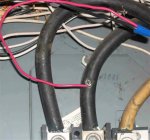jaggedben
Senior Member
- Location
- Northern California
- Occupation
- Solar and Energy Storage Installer
...
705.12(D)(2)(1) concerns feeders, where a PV system interconnection point is made at a feeder conductor. Note that this is not a tap, and the tap rules don't apply.
705.12(D)(2)(2) talks about how to treat a non-PV related tap in a feeder that also has a PV system interconnection (not considered at tap) made elsewhere on the feeder.
The following reference to 705.12(D)(2)(2) is from the Apr/May 2014 edition of SolarPro:
"Pre-exiting taps or taps added to a feeder with a PV supply source must be sized per 705.12(D)(2)(2) and 240.21(B), based on the sum of 125% of the inverter(s) output-circuit current plus the feeder OCPD rating. See Figure 3 for an example tap conductor calculation. Note that inverter output-circuit conductors, which must not have an ampacity less than the rating of the circuit OCPD, cannot meet the definition of a tap conductor."
...
Okay, well... I categorically disagree with the parts in red. I can get behind that 705.12(D)(2)(2) applies to all taps, whether they are for a load or a source, in the 2014 code. But I don't see anything, in your link or in the code or anywhere, which overrides the 240 definition of a tap. And the statement I highlighted from the solar pro article quote is... well, completely mistaken.
Let's take a practical example: if I want to tap a 1000amp feeder with a 20amp source and run the source conductors to another enclosure, it cannot be the case that the source conductors are required to be either only 20amp (unsafe) or 1000amp (overkill). They should be for example something like 100amp (or 102amp) based on 240.21B(1) for less than 10ft. That's exactly the sort situation the tap rules are in there to address.
Finally, see the new section in the 2017 code 705.65(C), which establishes that 240.21(B) rules do apply to power source taps, as one of two minimums. I dont really agree with the way they did it (putting it in a far away section where I suspect many people will not notice) but that was the CMP's way of addressing misconceptions over how to apply the tap rules to pwer source taps.


